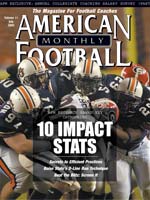AMERICAN FOOTBALL MONTHLY THE #1 RESOURCE FOR FOOTBALL COACHES
Article CategoriesAFM Magazine
|
10 Impact Stats to Build a Championship TeamAFM has researched and ranked the top statistical categories that you must excel in on the field to win a championship.by: W. Keith Roerdink © More from this issue There are lies and myths in the game of football. There are tried-and-trues that coaches cling to. But one thing is for sure: Statistics don’t lie. American Football Monthly examined every statistical category among the top ten teams in NCAA Division I-A football over the past five years in search of the numbers that define success among the best of the best. But moreover, these are numbers that define success at every level of the game: Pro, Div. I-A, Div. I-AA, Div. II, Div. III, NAIA, Junior College and High School. By charting the teams’ ranking in each category, we were able to come up with a five year total. The lower the overall number, the greater impact that category had on winning. As it turns out, the old adage that ‘defense wins ball games’ is....The full article can only be seen by subscribers. Subscribe today!
|
|
|||||||
| HOME |
MAGAZINE |
SUBSCRIBE | ONLINE COLUMNISTS | COACHING VIDEOS |
Copyright 2026, AmericanFootballMonthly.com
All Rights Reserved





